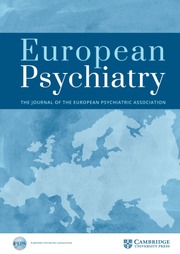No CrossRef data available.
Article contents
A psychophysiological investigation of emotional processing in subjects with panic disorder
Published online by Cambridge University Press: 16 April 2020
Abstract
Recent evidence reveals that subjects with panic disorder tend to interpret ambiguous stimuli as dangerous and/or threatening and present an attentional bias for threat-related cues. The present study is aimed to investigate, by means of high temporal resolution imaging techniques, the automatic processing of emotional stimuli in subjects with panic disorder (PD).
To this aim, we enrolled 33 drug-free patients with a DSM-IV diagnosis of PD and 26 healthy controls. The two groups were comparable for age, education and gender distribution. Event-related potentials (ERP) were recorded from 30 scalp electrodes while subjects were attending a modified visual oddball task, in which rare target and frequent standard stimuli were randomly intermixed with emotional (neutral, phobic, erotic and threatening) rare distractors. The topographic characteristics of the ERP components were analyzed using the brain electrical microstates (BEM) technique.
Patients with PD had a shorter duration of the first microstate for all distractors, except for the threatening stimuli, as compared to controls; in PD patients, the processing of threatening stimuli was associated with a different microstate sequence in early cognitive stages and a longer duration of microstate classes in early and late cognitive stages, with respect to healthy subjects.
In line with previous findings, our study showed abnormalities of emotional processing in subjects with PD. Furthermore, in line with cognitive models of PD, our results indicate an attentional bias for threatening information.
- Type
- Poster Session 2: Anxiety, Stress Related, Impulse and Somatoform Disorders
- Information
- European Psychiatry , Volume 22 , Issue S1: 15th AEP Congress - Abstract book - 15th AEP Congress , March 2007 , pp. S289
- Copyright
- Copyright © European Psychiatric Association 2007



Comments
No Comments have been published for this article.